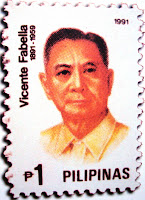Pio Valenzuela on Stamps

Pío Valenzuela (July 11, 1869-April 6, 1956) was a Filipino physician and patriot who was among the leaders of the Katipunan that started the Philippine Revolution against Spain. Valenzuela City in northern Metro Manila was named after him.
He wrote his memoirs of the Philippine Revolution in the 1920s, but historians have since been wary of his autobiography because of some inconsistencies in his version of events, particularly about his meeting with José Rizal in Dapitan in 1896. Valenzuela was the first mayor (American regime) of municipality of Polo (now Valenzuela City) from 1899-1900 before he became the governor of Bulacan province from 1921-1925.
Valenzuela was born in Polo, Bulacan (Now Barangay Polo, Valenzuela City) to Francisco Valenzuela and Lorenza Alejandrino, who both came from wealthy families. After he was tutored at home, he was brought to Manila to study at Colegio de San Juan de Letran. In 1888, he enrolled at University of Santo Tomas and finished his Licenciado en Medicina in 1895. He practices his profession in Manila and Bulacan.
In July 1892, when he was a medical student and the Katipunan was barely a week old, he joined this secret organization. He became a close friend of its founder, Andrés Bonifacio, and was godfather to the Supremo’s and Gregoria de Jesús’s first child. After their house burned down, Bonifacio and his family lived with Valenzuela in the latter’s house.
He was elected fiscal of the secret society in December 1895. He was inducted together with the other elected officials at Bonifacio's home on New Year's Day in 1896. Shortly after his induction, Valenzuela moved to San Nicolas district in Manila so he could supervise the publication of the secret society's official organ. Valenzuela claimed in his memoirs that he was supposed to be the editor of the publication but Emilio Jacinto would eventually be the one to supervise its printing.
Valenzuela said he was the one who suggested the name Kalayaan (Freedom) for the publication. To mislead the Spanish authorities, he also suggested that they place the name of Marcelo H. del Pilar as editor and Yokohama, Japan as the place of publication.
Kalayaan's first number, dated January 18, 1896, came out in March 1896 and consisted of a thousand copies which was distributed to Katipunan members all over the country. However, the publication only came out with one more issue because the Katipunan had already been uncovered by the Spanish authorities. He considered the publication of Kalayaan as the most important accomplishment of the secret chamber of the Katipunan, which he claimed consisted of himself, Bonifacio and Jacinto.
In a meeting of the secret chamber in July 1896, they decided to assassinate the Spanish Augustinian friar who uncovered the Katipunan to the authorities, but they failed to accomplish the mission. Valenzuela also claimed that after the discovery of the Katipunan, he and Bonifacio distributed letters implicating wealthy Filipinos, who refused to extend financial assistance to the Katipunan.
He was a member of the committee that was tasked to smuggle arms for the Katipunan from Japan. He was also with Bonifacio, Jacinto and Procopio Bonifacio when they organized the Katipunan council in Cavite. At the secret general meeting called by Bonifacio on the night of May 1, 1896 at Barrio Ugong in Pasig, Valenzuela presented to the body a proposal to solicit contributions to buy arms and munitions from Japan. The proposal was approved on condition that it first be approved by José Rizal, who was in exile in Dapitan in Mindanao.
Valenzuela was tasked to discuss the matter with Rizal and he left for Dapitan on June 15, 1896. However, Rizal told him that the revolution should not be started until sufficient arms had been secured and the support of the wealthy Filipinos had been won over. When the Katipunan was discovered, he fled to Balintawak on August 20, 1896, but he later availed of an amnesty that the Spanish colonial government offered and he surrendered on September 1, 1896. He was deported to Spain where he was tried and imprisoned in Madrid. He was later transferred to Málaga, Barcelona and then to a Spanish outpost in Africa. He was incarcerated for about two years.
He returned to the Philippines in April 1899. In Manila, he was denounced to the American Military authorities as a radical propagandist and once more imprisoned up September of the same year. To suppress aggressive leadership upon his release, he was made municipal president of Polo. From 1902 to 1919, he served as president of the military division of his district. From 1919 to 1925, he served the people of Bulacan for two terms as provincial executive. As governor, he was uncompromising against graft and corruption in the government.
After he retired from politics, he wrote his memoirs on the revolutionary days. He also practiced his medical profession, but only for philanthropic purposes. He was married to Marciana Castro by whom he had seven children. Early in the morning of April 6, 1956, he died in his hometown.
The stamp above was issued in 1974.






